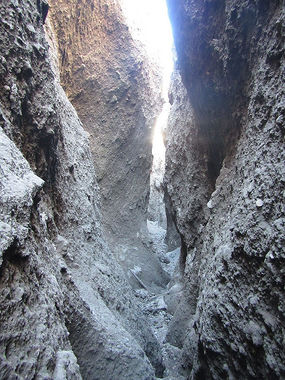Whitehorse Creek
| Rating: | |||||||||||||||||||||||||||||||
|---|---|---|---|---|---|---|---|---|---|---|---|---|---|---|---|---|---|---|---|---|---|---|---|---|---|---|---|---|---|---|---|
| | Difficulty:3A I (v2a1 I) Raps:1, max ↨10ft
Red Tape:No permit required Shuttle:None Vehicle:Passenger | ||||||||||||||||||||||||||||||
| Location: | |||||||||||||||||||||||||||||||
| Condition Reports: | 31 Aug 2014
"Totally dry, but still minor rockfall hazard. Not a major canyoneering objective, but still a cool place to visit. |
||||||||||||||||||||||||||||||
| Best season: | July-Sept
|
||||||||||||||||||||||||||||||
| Regions: | |||||||||||||||||||||||||||||||
Introduction[edit]
Bizarre slot canyon / narrows carved out through compacted pumice on SW slopes of Crater Lake. There may be water running earlier in the season, but it dries up heading into late summer. A helmet is essential per constant rockfall hazard. In visiting in late summer 2014, there was a constant light stream of fine gravel and pebbles coming down from above. The canyon may be more dangerous in wet conditions.
Visiting the narrows is short & sweet. Expect to spend a couple of hours. It's usually an out & back.
Approach[edit]
From the junction with the south entrance to Crater Lake, head west on Hwy 62 for 3.8mi. At 3.5mi, Whitehorse Creek passes through a culvert underneath the road. It's easy to miss, so watch your mileage. Continue 0.3mi further west to a parking pullout on the north side of the road.
From the parking area, backtrack along Hwy 62 to the creek and thrash north along the east side of the Whitehorse Creek. Keep going for 0.25mi and use an obvious side drainage to enter the creek. Go downstream.
Descent[edit]
Follow the creek downstream as it entrenches and slots up in the compacted pumice.
- R1: 10ft. In 2014 used a large log as an anchor to rap down. Set a fixed rope if you are planning to return the same way.
Below the canyon stays tight for a short distance with some easy downclimbs before opening up into a nice narrows with overhanging walls and a big alcove. Continue downstream to reach the confluence with Castle Creek. Reportedly huge blocks of snow can be found here into late summer.
Exit[edit]
Return the way you came. Be prepared to re-ascend your rope.
Red tape[edit]
None.
Beta sites[edit]
 CanyoneeringNorthwest.com (archive.org) : Llaos Hallway - Whitehorse Creek
CanyoneeringNorthwest.com (archive.org) : Llaos Hallway - Whitehorse Creek
Trip reports and media[edit]
Background[edit]
Further Explorations[edit]
- It might be possible to head up or downstream on Castle Creek and thrash out elsewhere to do a loop.
- Little Castle Creek looks interesting.
